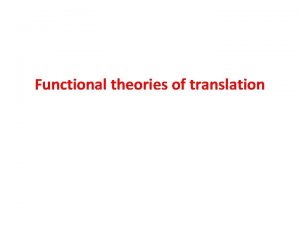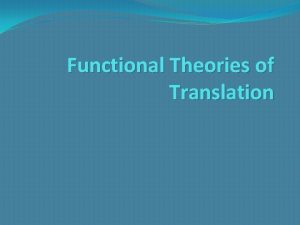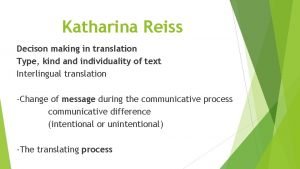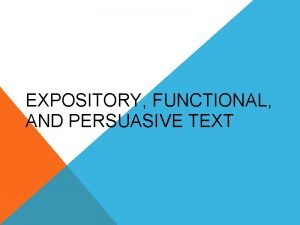Functional Theories of Translation Katharina Reisss Text Type











- Slides: 11

Functional Theories of Translation

Katharina Reiss’s Text Type �Systematizing the assessment of translations according to text type and function. �Characteristics of each text type: Ø Informative Ø Expressive Ø Operative Ø Audiomedial (p. 73, Table 5. 1)

Text type model Informative reference work report, lecture tourist brochure biography sermon play electoral speech poem satire advertisement Expressive Operative

Criteria of Adequacy of the TT �Assessment of the adequacy of the TT according to: ØIntralinguistic criteria ØExtralinguistic criteria �Application of criteria according to text type �Occasions where the TT function differs from the ST function. (Example: Gulliver’s Travels)

Mary Snell Hornby’s Integrated Approach �Attempts to integrate a wide variety of different linguistic and literary concepts in an integrated approach to translation. �A “stratificational model” from the most general to the most particular �Study diagram on p. 76

Holz-Mänttäri’s Translatorial Action Model �Translation is purpose-driven, outcome-oriented human interaction. �The process of Translation involves the intercultural transfer of message-transmitter compounds “ [It] is not about translating words, sentences or texts but is in every case about guiding the intended co-operation over cultural barriers enabling functionally oriented communication”. (Holz-Mänttäri, 1984)

Translatorial Action (Cont. ) �Interlingual translation is “translatorial action from a source text” and is a “communicative process involving a series of roles and players”: 1. The initiator 2. The commissioner 3. The ST producer 4. The TT producer 5. The TT user 6. The TT receiver

Translatorial Action (Cont. ) �In the production of the TT, the ST is analyzed only for its “construction and function”. Relevant features are described according to : Ø Content: structured into: 1. factual information 2. overall communicative strategy Ø Form: structured into: 1. terminology 2. cohesive elements

Skopos Theory �Meaning of skopos �Hans J. Vermeer & Katharina Reiss �Focus : the purpose of the translation �The purpose determines the methods and strategies �Aim: to produce a functionally adequate result �The result is the TT, or translatum (Vermeer) �Conclusion: Why the ST needs translation & the function expected of the TT are crucial

Rules of the Skopos theory: 1. A translatum (or TT) is determined by its skopos 2. A TT is an offer of info. in a target culture and TL , concerning an offer of info. in a source culture and SL. 3. A TT does not initiate an offer of information in a clearly reversible way. 4. A TT must be internally coherent. (coherence rule) 5. A TT must be coherent with ST. (fidelity rule) 6. The 5 rules above stand in hierarchical order, with the skopos rule predominating

Christiane Nord Translation-Oriented Text Analysis �Christiane Nord’s types of texts: Ø Documentary translation: Ø An instrumental translation: ‘function preserving translations’ or translations un-preserving function �Aspects of functionalist approaches useful for translator training: Ø The importance of the translation commission Ø The role of ST analysis Ø The functional hierarchy of translation problems
 Katharina reiss functional theory
Katharina reiss functional theory Katharina reiss
Katharina reiss Making connections
Making connections Katharina reiss text types
Katharina reiss text types Expository text mean
Expository text mean Semi fixed space maintainer
Semi fixed space maintainer Non functional plasma enzymes
Non functional plasma enzymes Functional and non functional plasma enzymes
Functional and non functional plasma enzymes Functional and non functional
Functional and non functional Communicative vs semantic translation
Communicative vs semantic translation Number translation using voice translation profiles
Number translation using voice translation profiles Transformation of functions
Transformation of functions





















